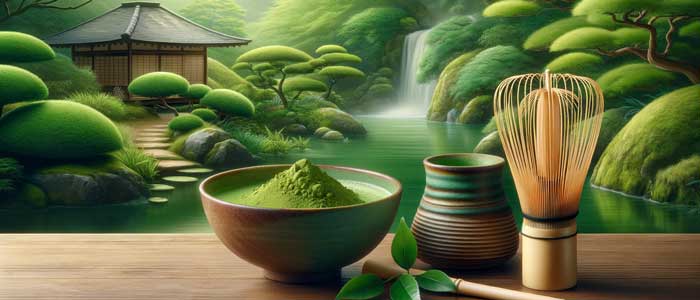Matcha. It’s not just a trend; it’s a lifestyle. But here’s the kicker – not all matcha is created equal. The big elephant in the room? Pesticides in matcha. This is the gritty reality we need to face head-on, both as consumers and producers. It’s like finding out your favorite superhero has a hidden flaw.
You see, pesticides in matcha isn’t just a buzzphrase; it’s a wake-up call. Why does it matter? Well, for starters, we’re talking about what you’re putting into your body. And for the hardworking folks growing this green gold, it’s about preserving the legacy of what they’re putting out into the world.
This isn’t just about sipping a calming cup of tea; it’s about understanding what goes into that cup. It’s about making sure that every sip is as honest and clean as the clear blue sky. So, let’s dive deep and sift through the nitty-gritty of what’s really in your matcha. Spoiler alert: It’s going to be a journey worth taking.
Understanding Matcha and Its Production
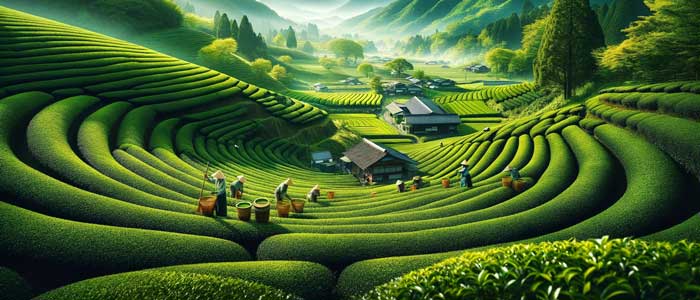
Matcha isn’t just your average green tea; it’s a game-changer in the world of teas. Made from whole tea leaves ground into a fine powder, it’s like the superhero of teas with its vibrant green color and a truckload of health benefits. This isn’t your regular tea bag stuff; we’re talking about leaves that have been pampered with shade for weeks before harvest, boosting their chlorophyll and amino acids. It’s like giving the leaves a luxury spa treatment, so they come out looking and tasting top-notch.
Now, let’s talk about Uji, Japan – the big leagues of matcha production. This place is to matcha what Hollywood is to movies. It’s got the perfect mix of climate and tradition, making it the dream destination for any self-respecting matcha leaf. The methods here aren’t just about making tea; they’re about upholding centuries-old traditions. It’s like keeping a sacred tea-making secret alive.
And here’s where it gets real: organic farming. We’re not just jumping on the organic bandwagon for the heck of it. Going organic in matcha cultivation is like choosing to eat a home-cooked meal instead of fast food. By ditching those nasty synthetic pesticides and fertilizers, farmers ensure your matcha is as pure as it gets. It’s better for you, the planet, and let’s face it, it just tastes a whole lot better. This is about keeping it real with the soil, the environment, and, most importantly, with you. Organic farming isn’t just a choice; it’s a commitment to delivering a cup of matcha that’s as honest and authentic as the day is long.
The Issue of Pesticides in Matcha

Alright, let’s cut to the chase and talk about matcha pesticides. It’s like opening Pandora’s box – you don’t know what you’ll find, but you’ve gotta look. In the matcha world, pesticides can be the uninvited guests at a party, sneaking in to crash the scene. These chemicals, often used to keep pests away, can range from your run-of-the-mill insecticides to more complex fungicides and herbicides. It’s a cocktail of stuff you probably wouldn’t invite over for dinner.
Now, why do some folks use pesticides in matcha production? It’s a bit like using cheat codes in a video game – they make the job easier but at what cost? These pesticides are meant to boost yields and keep those pesky bugs at bay. But here’s the rub: while they’re doing their thing, they can sneak into your matcha, turning your zen moment into a not-so-zen experience. We’re talking about impacts on the quality and safety of your beloved green powder. It’s like finding out your favorite snack is made with ingredients you can’t even pronounce.
Let’s take a detour to Australia and discuss pesticides in matcha Australia. This isn’t just about what’s happening in your backyard; it’s a global issue. Different countries, different rules. In Australia, for instance, they’ve got their playbook when it comes to regulating these pesky pesticides. It’s like comparing barbeque styles across the world – everyone’s got their unique way of doing it. Understanding these regional differences is key because, at the end of the day, you want to know what’s in your cup, no matter where it’s coming from.
So there you have it – the lowdown on pesticides in your matcha. It’s a bit like uncovering the secret ingredients in your grandma’s famous recipe: some things are better left out. Stay tuned, because this story is just getting started.
Health Implications
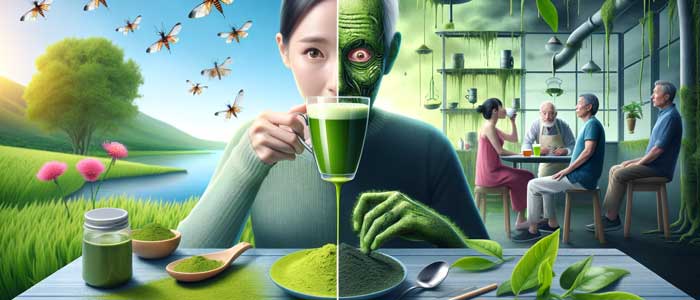
Let’s talk about the elephant in the room: the health risks of chugging down matcha laced with pesticides. It’s like finding out your health elixir might have a dark side. Imagine this: You’re enjoying your daily cup of matcha, thinking you’re doing your body a favor, but little do you know, there might be some uninvited chemicals doing the tango in your tea.
The potential health risks of consuming matcha contaminated with pesticides aren’t something to sweep under the rug. It’s serious business. We’re talking about risks that can range from the mild – like an upset tummy – to the more severe and downright scary, like long-term health issues. It’s like playing Russian roulette with your health; you never know what you’re going to get.
And it’s not just hearsay. Studies and findings diving into the world of pesticides in matcha powder are painting a picture we can’t ignore. These aren’t just numbers on a page; they’re real concerns. Some research suggests that certain pesticides can mess with your body in ways you wouldn’t want your worst enemy to experience. From hormonal disruptions to more ominous long-term effects, it’s like finding out there’s a glitch in your favorite video game, but this time, it’s your health on the line.
So, as we sift through these studies, it’s like putting together a puzzle. The picture? The true impact of what these pesticides can do when they hitch a ride on your matcha powder. It’s a wake-up call, a moment to pause and think, “What’s really in my cup?” As we dive deeper, remember, knowledge is power, especially when it comes to what we put in our bodies. Stay tuned, because this is a conversation worth having.
[Source: Exposure Routes and Health Risks Associated with Pesticide Application]
Regulations and Standards
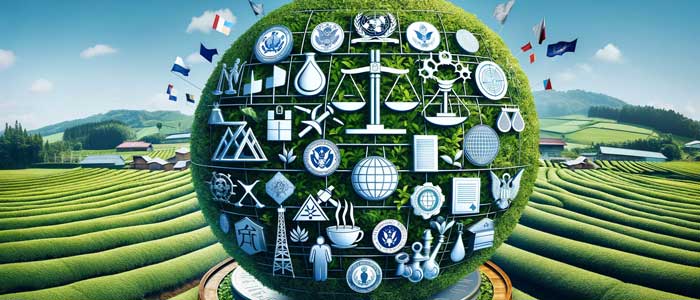
Now, let’s navigate the maze of regulations and standards surrounding the use of pesticides in matcha production. It’s like trying to read the fine print on a contract – necessary but a bit of a headache. These regulations are the rulebook for keeping things in check, and trust me, it’s a hefty book.
On the international stage, there’s a whole array of guidelines and limits set by big players like the World Health Organization (WHO) and the Food and Agriculture Organization (FAO). They lay down the law on what’s okay and what’s not in terms of pesticide use. Think of them as the referees in the matcha game, ensuring everyone plays fair for the sake of public health.
But it’s not just a global affair. Locally, countries have their own set of rules. It’s like each country has its own recipe for a safe cup of matcha. In some places, the regulations are tighter than a drum, with rigorous testing and strict limits. In others, well, let’s just say it’s a bit more relaxed. The keyword here is pesticides in matcha powder. This is where the rubber meets the road. These local regulations directly impact the safety and purity of the matcha powder winding up in your kitchen.
The differences in standards and enforcement can be stark. It’s like comparing different traffic laws in various cities. Some are super strict with speed limits, while others let you cruise a bit more freely. And just like in traffic, these differences can have real-world impacts. In the case of matcha, it’s all about the safety and quality of what you’re sipping.
So, as we delve into this world of regulations, remember, they’re there for a reason. These rules and standards are the unsung heroes in the battle for safe, clean matcha. They might not make headlines, but they’re working behind the scenes to ensure your matcha moment is as pure and safe as can be.
Organic Matcha – A Safer Alternative

Let’s turn the spotlight on organic matcha, the clean, green, fighting machine in the world of teas. Going organic isn’t just a trendy choice; it’s like choosing a vintage vinyl record over a streaming service – it’s about quality, authenticity, and a nod to the good old ways.
Opting for 100% organic and pesticide-free matcha is like picking the VIP ticket in a sea of general admission. This stuff is the real deal. We’re talking no chemical pesticides, no synthetic nasties – just pure, unadulterated matcha goodness. It’s like your tea is getting a green thumbs-up from Mother Nature herself. The benefits? Oh, they’re as clear as day. Think better health, a cleaner conscience, and a cup of tea that’s as nature intended.
But wait, it gets better. The certification process for organic matcha isn’t just a pat on the back; it’s a rigorous, no-stone-unturned checkup. This is where matcha gets put under the microscope, literally. Certified organic matcha means it’s passed the test, proving it’s free from all those unwanted chemicals. For consumers, this certification is like a seal of approval. It’s the peace of mind that what you’re sipping is as clean as it gets.
So, when you go for organic matcha, you’re not just making a choice for yourself; you’re making a statement. You’re saying yes to health, yes to the environment, and yes to a tradition that respects the earth and everything it offers. In a world where shortcuts and quick fixes are the norms, choosing organic matcha is like choosing the road less traveled – and trust me, it makes all the difference.
How Consumers Can Make Informed Choices
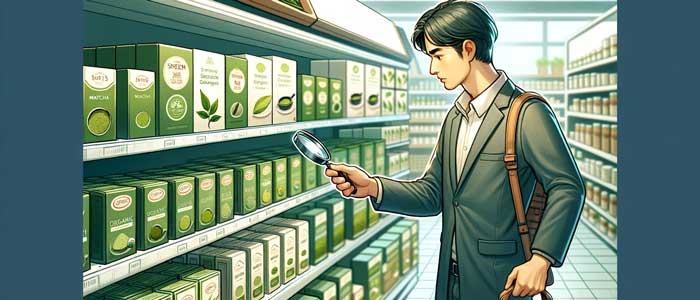
Making the right choice when it comes to matcha is like being a detective in a world full of clues. It’s not just about picking any green tin off the shelf; it’s about making an informed, savvy choice. So, here’s how you can play the sleuth in the matcha aisle.
First up, quality check. High-quality, pesticide-free matcha should scream excellence from the get-go. It’s like picking the ripest, juiciest apple in the bunch. Look for a vibrant green color, a fine, silky texture, and a fresh, grassy aroma. This isn’t your average, run-of-the-mill green tea powder. This is the crème de la crème of matcha, and it should look and smell the part.
Now, let’s talk labels and certifications. This is where you need your magnifying glass. Labels are like the tea’s CV, listing its qualifications and past life. Look for certifications like USDA Organic or JAS (Japanese Agricultural Standard) organic. These aren’t just fancy stickers; they’re proof that what you’re getting is the real McCoy, free from those pesky pesticides. But beware of misleading buzzwords like ‘natural’ or ‘pure’ – they can be as empty as a politician’s promises.
Finally, the big kahuna: sourcing and transparency. Knowing where your matcha comes from is like knowing the origins of your family heirloom – it’s crucial. The best producers aren’t just about making matcha; they’re about making a statement. They’re transparent about their farming practices, their regions, and their processing methods. It’s not just about slapping a label on a tin; it’s about tracing the journey from leaf to latte.
So there you have it, your very own guide to picking the perfect matcha. It’s about being informed, being curious, and above all, being conscious of the choices you make. Remember, every time you pick a tin of matcha, you’re casting a vote for the kind of world you want to live in. Make it count.
The Future of Matcha Production

As we look into the crystal ball of matcha production, one thing’s clear: the future is as green and promising as a freshly brewed cup of this magical tea. The trends in matcha cultivation, particularly regarding pesticide use, are shifting faster than the seasons, and it’s an exciting time to be a matcha enthusiast.
In the future, we can expect a seismic shift towards more sustainable and organic farming practices. It’s like watching the organic food movement take the world by storm, only this time, it’s all about matcha. The use of pesticides? We’re likely to see that become as outdated as dial-up internet. Farmers are already experimenting with innovative, eco-friendly ways to protect their crops, like using natural predators for pests or organic fertilizers. It’s about working with nature, not against it.
But here’s the real game-changer: you, the consumer. The role of consumer awareness and demand in shaping these trends is like the wind beneath the wings of the matcha industry. As more and more people start to demand cleaner, greener matcha, producers are listening. It’s a two-way conversation where your voice, your choices, and your preferences are driving real change.
We’re talking about a future where every scoop of matcha comes with a story – a story of ethical farming, environmental respect, and a commitment to health. This isn’t just wishful thinking; it’s a movement, and it’s gaining momentum. With every cup of matcha you enjoy, you’re not just savoring a delicious beverage; you’re being part of a global shift towards a more sustainable and transparent food industry.
So, as we step into this bright future, remember that your choices are powerful. They’re shaping the way matcha is grown, processed, and enjoyed around the world. The future of matcha production is looking brighter than ever, and it’s a future that we’re creating together, one cup at a time.
Conclusion
In wrapping up our deep dive into the world of matcha, it’s clear that this isn’t just about a tea; it’s about a journey. We’ve sifted through the nitty-gritty of what makes matcha more than just a trendy drink – from its unique production process steeped in tradition to the pressing concerns about pesticides in matcha.
We kicked off by exploring matcha’s roots, understanding its meticulous production, and spotlighting Uji, Japan, where matcha isn’t just made; it’s crafted with centuries-old wisdom. The critical issue of pesticides in matcha took center stage, revealing how these chemicals, often used for convenience, can sneak into our cups, potentially altering the essence and safety of our beloved green powder.
Health implications can’t be ignored. The potential risks of pesticides in matcha range from minor discomforts to significant health concerns, underscoring the need for rigorous research and consumer awareness. We navigated through the complex web of international and local regulations, understanding that these standards are the guardians of matcha’s purity and safety.
The beacon of hope in this narrative is organic matcha – the cleaner, greener alternative. By choosing 100% organic, pesticide-free matcha, we’re not just making a health choice; we’re making a statement about the kind of world we want to live in. It’s a vote for sustainability, authenticity, and respect for nature.
As consumers, we wield enormous power. Our choices, our demands for transparency, and our insistence on quality are reshaping the matcha industry. We’re driving a shift towards more sustainable practices, a movement where our health and the planet’s wellbeing are at the forefront.
So, as you stand before the array of matcha choices, remember the journey from leaf to cup. Be mindful of the impact of pesticides in matcha, not just on your health but on the environment as well. Seek out certified organic matcha, for it’s not just the safer choice; it’s the future. Each cup of matcha is a story – a story of tradition, of health, and of a greener world. Choose wisely, for in each choice lies the power to shape a better future.
FAQ: Matcha Pesticides
Are pesticides used in matcha?
The use of pesticides in matcha production varies. While some producers use pesticides to protect crops, others adhere to organic farming methods without them.
Does matcha powder need to be organic?
While not a requirement, organic matcha ensures no synthetic pesticides or fertilizers are used, which can be preferable for health and environmental reasons.
Does matcha have chemicals?
Matcha can contain chemicals from pesticides if not grown organically. However, certified organic matcha is free from synthetic chemicals.
Is matcha high in heavy metals?
Matcha can contain trace amounts of heavy metals naturally found in soil, but levels are typically low. Organic farming practices can help minimize this.
How can I ensure my matcha is free from harmful pesticides?
Look for certifications like USDA Organic or JAS Organic on the label, which indicate the matcha is produced without harmful pesticides.
What are the health implications of pesticides in matcha?
Pesticides in matcha can potentially pose health risks, ranging from minor ailments to more serious long-term health issues.
Can the way matcha is processed reduce pesticide residues?
Processing methods can impact residue levels, but the best way to avoid pesticides is to choose matcha grown organically from the start.
Are there any natural alternatives to pesticides used in matcha farming?
Yes, many organic matcha producers use natural alternatives like biological pest control and organic fertilizers.
Is there a taste difference between organic and non-organic matcha?
Some connoisseurs claim organic matcha has a purer, more robust flavor, though this can be subjective and vary by brand and quality.
What impact does pesticide use in matcha production have on the environment?
Pesticide use can affect local ecosystems, including soil health and nearby wildlife, which is why many advocate for organic farming practices.

